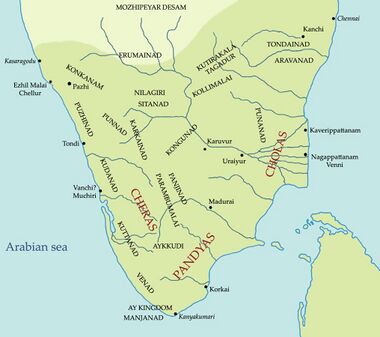History:Sangam period
 Tamilakam, located in the tip of South India during the Sangam Period, ruled by Chera dynasty, Chola dynasty and the Pandyan dynasty | |
| Alternative names | Sangam Age, Third Sangam period, Last Sangam period |
|---|---|
| Geographical range | Indian subcontinent |
| Period | Iron Age India |
| Dates | c. 600 BCE – c. 300 CE |
| Major sites | Keezhadi excavation site, Kodumanal, Arikamedu, Murugan Temple, Saluvankuppam, Adichanallur |
The Sangam period or age (Template:Indic, Template:Indic), particularly referring to the third Sangam period, is the period of the history of ancient Tamil Nadu and Kerala (then known as Tamilakam), and parts of Sri Lanka dating back to c.6th century BCE.[1] It was named after the legendary Sangam academies of poets and scholars centered in the city of Madurai[2] which are believed to be mythical.
In Old Tamil language, the term Tamilakam (Tamiḻakam, Purananuru 168. 18) referred to the whole of the ancient Tamil-speaking area,[3] corresponding roughly to the area known as southern India today, consisting of the territories of the present-day Indian states of Tamil Nadu, Kerala, parts of Andhra Pradesh and Karnataka. Whereas Sri Lanka is distinguished from it and is known as Ilam or Eelam,[4] although also influenced by the Sangam Period.[5][6][7]
History
According to Tamil legends, there were three Sangam periods, namely Head Sangam, Middle Sangam and Last Sangam period. Historians use the term Sangam period to refer the last of these, with the first two being legendary. It is also called the last Sangam period (Template:Indic),[8] or third Sangam period (Template:Indic).
The Sangam literature is thought to have been produced in three Sangam academies of each period. The evidence on the early history of the Tamil kingdoms consists of the epigraphs of the region, the Sangam literature, and archaeological data. The period between 600 BCE to 300 CE, Tamilakam was ruled by the three Tamil dynasties of Pandya, Chola and Chera, and a few independent chieftains, the Velir.
| Sangam | Time span | No. of Poets | Kingdom[9] | Books[9] |
|---|---|---|---|---|
| First | 4440 years[9](from 9600 BCE to 5200[10] BCE) | 549[9] | Pandiya | No books survived |
| Second | 3700 years[9]( | 1700[9] | Pandiya | Tolkāppiyam (author - Tolkāppiyar) |
| Third | 1850 years[9] | Pandiya | covers entire corpus of Sangam Literature |
Literary sources

There is a wealth of sources detailing the history, socio-political environment and cultural practices of ancient Tamilakam, including volumes of literature and epigraphy.[6]
Culture
The Sangam Tamils enjoyed a sophisticated cultural life. Their interests in education, literature, music, dance, drama and festivals have been described in the Sangam literature.
Society
The fourfold Vedic system of caste hierarchy did not exist during the Sangam period. The society was organised by occupational groups living apart from each other.[12]
See also
- History of Tamil Nadu
- Tolkappiyam
- Purananuru
- Paripaatal
References
- ↑ Jesudasan, Dennis S. (2019-09-20). "Keezhadi excavations: Sangam era older than previously thought, finds study" (in en-IN). The Hindu. ISSN 0971-751X. https://www.thehindu.com/news/national/tamil-nadu/keeladi-findings-traceable-to-6th-century-bc-report/article29461583.ece.
- ↑ Dr. Anjali (2017). Social and Cultural History of Ancient India. Lucknow: OnlineGatha—The Endless Tale. pp. 123–136. ISBN 978-93-86352-69-9.
- ↑ Saju, M. T. (September 20, 2019). "Carbon dating confirms Keeladi 3 centuries older" (in en). https://timesofindia.indiatimes.com/city/chennai/carbon-dating-confirms-keeladi-3-centuries-older/articleshow/71209468.cms.
- ↑ Pierre-Yves Manguin; A Mani; Geoff Wade (2011). Early Interactions Between South and Southeast Asia: Reflections on Cross Cultural exchange. Institute of Southeast Asian Studies. ISBN 9789814345101. https://books.google.com/books?id=ni9AlOLTFZYC&q=tamilakam+northern+sri+lanka&pg=PA138.
- ↑ Wilson, A.Jeyaratnam (2000). Sri Lankan Tamil Nationalism: Its Origins and Development in 19th and 20th Centuries. UBC Press. ISBN 9780774807593. https://books.google.com/books?id=W3aAB9IFVdkC&q=tamilakam+northern+sri+lanka&pg=PA14. Retrieved 2012-04-28.
- ↑ 6.0 6.1 Abraham, Shinu (2003). "Chera, Chola, Pandya: using archaeological evidence to identify the Tamil kingdoms of early historic South India". Asian Perspectives 42 (2): 207–223. doi:10.1353/asi.2003.0031. https://www.questia.com/googleScholar.qst;jsessionid=GfpTLJYcL1XJGP4Vv1mSvT1hvmCvCxGMhrrDBZ23l2vmKVN1JkYG!-2096127210?docId=5002047766.
- ↑ "Women, Transition, and Change: A Study of the Impact of Conflict and Displacement on Women in Traditional Tamil Society". 1995. https://books.google.com/books?id=P1naAAAAMAAJ&q=nagadipa+naga+nadu.
- ↑ Zvelebil, Kamil (1973). The smile of Murugan on Tamil literature of South India. Brill. p. 46.
- ↑ 9.0 9.1 9.2 9.3 9.4 9.5 9.6 Daniélou, Alain (2003-02-11) (in en). A Brief History of India. Simon and Schuster. ISBN 9781594777943. https://books.google.com/books?id=xlwoDwAAQBAJ&q=sangam.
- ↑ M., Arunachalam (1989) (in english). Musical Tradition Of Tamilnadu (1st ed.). madras: International Society For The Investigation of Ancient Civilisations. pp. 11.
- ↑ Rosen, Elizabeth S. (1975). "Prince ILango Adigal, Shilappadikaram (The anklet Bracelet), translated by Alain Damelou. Review". Artibus Asiae 37 (1/2): 148–150. doi:10.2307/3250226.
- ↑ Nath sen, Sailendra (1999). Ancient Indian History and Civilization (Second ed.). Routledge. p. 205. ISBN 9788122411980. https://books.google.com/books?id=Wk4_ICH_g1EC&q=maurya+dynasty+sen.
Bibliography
- A. L. Basham, The Wonder that was India, Picador (1995) ISBN:0-330-43909-X
- P. T. Srinivasa Iyengar, History of the Tamils from the earliest times to 600 AD, Madras, 1929; Chennai, Asian Educational Svcs. (2001) ISBN:81-206-0145-9.
 |

